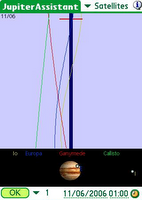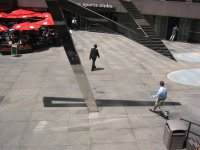Session name: 20060610.2100
This session was like none recent at TotL. It was alive with the hustle and bustle of regulars and new passersby up at TotL. At the end of the session when Charlie and I stood looking at the expanse of sky with its isolated bright stars, bags packed at our feet, Charlie mentioned that we really didn't observe much. We served the throngs of people that stopped to looks of Saturn, Mars, M44, Jupiter and the Moon.
Charlie and Tom had already been setup with their tripod mounted bins when I arrived. They were a bit farther east to see over the western horizon where Mercury was setting. As I was finishing setup, people came up asking if I was Peter. They said Tom sent them over to have some looks through the scope - the Tak FS102. I imagine that Tom gave the peeks through his 16x70 binoculars while he described to them what they were looking at.
Hawaiian George, Museum Michelle, Police Officer Matthew, Dogwalkers John & Claudia and Carol, and Publisher Mark would stop and congregate at TotL. Many others we met for the first time stopped by. A few remarked how they love to see us here with the bins and scopes that we make them feel safe. The infectious astro bug became apparent when some of the passersby would invite other pedestrians to have a look through the eyepiece. One of the larger gatherings was around 11 ~ 11:30 pm - here in the middle of Central Park, unplanned.
+++++++++++++

Charlie likes to pack up and get going by 1am. That's the park curfew and for a period of time the police would come by to remind us the park was closing. But on evenings like this one, I find it hard to leave. We had terrific transparency and the early Fall sky began to rise. Europa had just ingressed on Jupiterbit since seeing was not great, I could not see the moon on the limb. I'm sure once it got onthe disc entirely it would have been easy to see. Not wanting to remain in the park alone, I began to breakdown just before 1am.
The child within wasn't quite finished.
By 1:30am our bags were packed but I went into my backpack to recover my bins. Sagittarius and Scorpio were above the trees to the East, Cassiopeia had risen appreciably in the north. With bins in hand, I did a quick scan in Sagittarius only to see M22 as a pale glow inside of a long, narrow isoceles triangle. I looked around for M25 and M24 but didn't recognize anything. I stopped by M8 only to see NGC6530, the open cluster within.
Seeing Shaula & Lesath, lambda- & upsilon Scorpii, the stinger stars of Scorpio's, I thought of M7 & M6. Instead of the normal circuit, I hopped off eta Sagittarii to the upper right. Unmistakenly, M7 is a large bold cluster that stands out well against our low horizon. In contrast, M6 was nearly defeated as its faint light caused a slight blush on the background sky. Nearby in the Table of Scorpius, one of my favorite open clusters - NGC6231 - resides, but now wasn't the time to see it. A narrow observing window exists where it rises just above the treeline and clears the Citicorp building in the south. This would occur much later in the evening or another summer night later in the season.
Since it was coming on 2am, another evening it'll be. On the way home in the cab, I reflect on cheer of the people and the charm of the night.
peter
 Solstice, New York style at the McGraw-Hill Building on 6th Ave. Well Solstice passed, this is our huge sundial gnomon as the Sun Triangle indicating high noon.
Solstice, New York style at the McGraw-Hill Building on 6th Ave. Well Solstice passed, this is our huge sundial gnomon as the Sun Triangle indicating high noon. Looking from the east, shadow is west of the gnomon. Open triangle in the direction of south, pointed end north.
Looking from the east, shadow is west of the gnomon. Open triangle in the direction of south, pointed end north. This shadow slightly past noon. One can see the edge developing on the west side as the shadow will grow to the right (east).
This shadow slightly past noon. One can see the edge developing on the west side as the shadow will grow to the right (east). A small crowd had assembled and looked up the edge of the triangle. Remember all the warnings we've heard of not looking directly at the Sun? No compliers here.
A small crowd had assembled and looked up the edge of the triangle. Remember all the warnings we've heard of not looking directly at the Sun? No compliers here. This shows how long I stayed here for as the shadow has grown substantially to the east.
This shows how long I stayed here for as the shadow has grown substantially to the east.
 This session was like none recent at TotL. It was alive with the hustle and bustle of regulars and new passersby up at TotL. At the end of the session when Charlie and I stood looking at the expanse of sky with its isolated bright stars, bags packed at our feet, Charlie mentioned that we really didn't observe much. We served the throngs of people that stopped to looks of Saturn, Mars, M44, Jupiter and the Moon.
This session was like none recent at TotL. It was alive with the hustle and bustle of regulars and new passersby up at TotL. At the end of the session when Charlie and I stood looking at the expanse of sky with its isolated bright stars, bags packed at our feet, Charlie mentioned that we really didn't observe much. We served the throngs of people that stopped to looks of Saturn, Mars, M44, Jupiter and the Moon.




